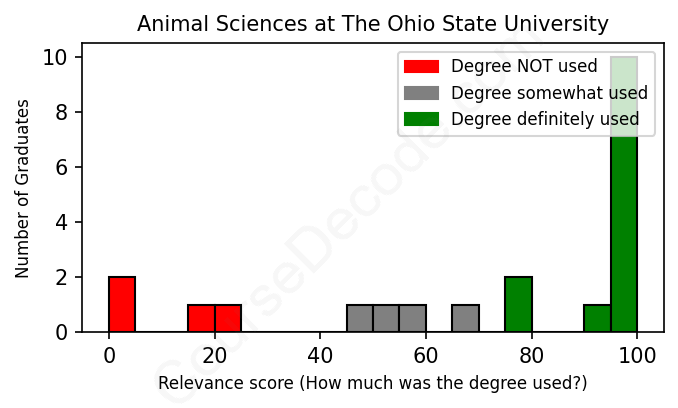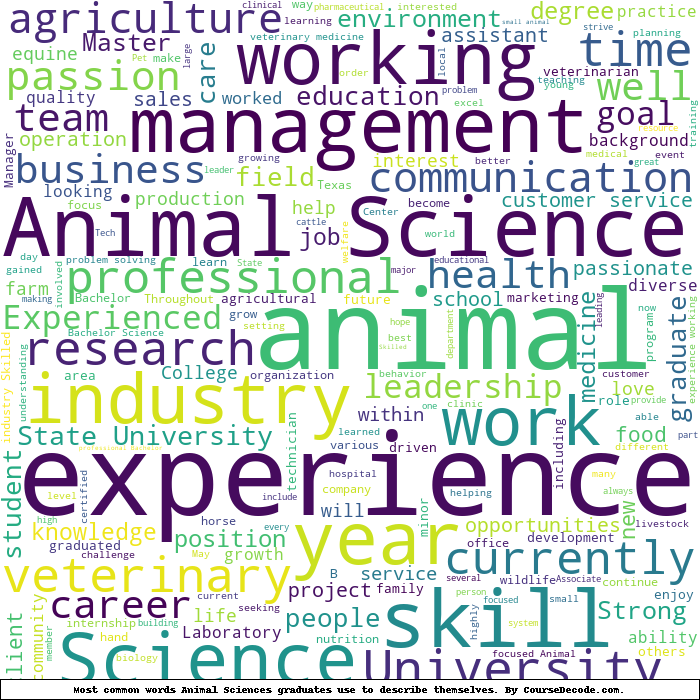
First, some facts. Of the Animal Sciences graduates from The Ohio State University we've analyzed , here's how many have used (or NOT used) their degree in their career:

These are estimates based on AI analysis of 21 LinkedIn profiles (see below).
The verdict? Slightly above average. Overall, with an average relevance score of 71%, Animal Sciences graduates from The Ohio State University have a slightly higher likelihood (+4%) of finding work in this field compared to the average graduate across all fields:
And for comparison, here's the chart for all profiles we've looked at across all degrees.
Also, after graduating, 42% of these graduates have pursued further education other than another Bachelor's degree (such as a Masters degree or other), compared to the average across all profiles of 35%. This suggests you may need more than just a Bachelors degree to be competitive as a Animal Sciences graduate.
See the details:
|
Relevance score: 100% We think this person has gone into a career highly relevant to their degree. We think this person has gone into a career highly relevant to their degree.
DEGREE INFOGraduated in 2012 from The Ohio State University with a Bachelor of Science (B.S.) in Animal Sciences. No other secondary education since. JOB HISTORY SINCE GRADUATIONStudent Researcher The Ohio State University May 2013 - Aug 2013 Veterinary Assistant  MedVet Hilliard Feb 2013 - Present ABOUTNo information provided. |
The top 10 most common jobs done by the graduates we've analyzed (ranked most common to least) are:
Based on the analysis of LinkedIn profiles of graduates with a degree in Animal Sciences from The Ohio State University, the most common job types are veterinary and animal care-related positions, research roles, and various compliance or quality assurance positions within the food industry. Roles such as Veterinary Assistant, Animal Care Technician, and Animal Science Educator reflect a direct application of their academic background in animal care and management, highlighting the relevance of their degree. Positions in research and animal husbandry also show significant alignment with the principles taught in their studies, allowing graduates to utilize their expertise effectively.
However, it's important to recognize that not all jobs taken by these graduates directly relate to Animal Sciences. Many have found themselves in roles outside of this field, such as those in customer service, sales, or administrative positions, which do not fully engage their specialized knowledge. Overall, while a good number of graduates are working in relevant fields that directly apply their Animal Sciences education, there's a notable segment working in areas where their degree's specific knowledge isn't fully utilized. This variation indicates that while earning a degree in Animal Sciences offers many potential career paths, the direct applicability to every job isn't guaranteed, depending on the individual's career choices and market conditions.
Here is a visual representation of the most common words in job titles for Animal Sciences graduates (this is across all Animal Sciences graduates we've analyzed, not just those who went to The Ohio State University):

Graduates from The Ohio State University with a degree in Animal Sciences seem to have a pretty diverse range of career paths, but many land in roles that are quite relevant to their studies directly after graduation. In the early stages of their careers, it's common for them to start off in hands-on roles like veterinary technicians, kennel workers, or assistants in animal care settings. For example, many graduates from the classes of 2010, 2011, and 2012 began their careers in positions such as veterinary assistants, quality assurance technologists, or farm-related roles. This shows that new grads often seek positions that give them direct experience working with animals or in related fields, setting a solid foundation for their skills and knowledge.
As these individuals progress in their careers—around five to ten years later—it's interesting to see a shift where some remain in animal care while others explore different sectors. Some move up into management positions, such as quality assurance managers or agricultural educators, while others drift into roles that are more detached from direct animal care, such as project management or sales representatives in the agricultural sector. This indicates that while a lot of graduates do follow their passion for animals, a fair number also branch out into various industries, leveraging their Animal Sciences background in broader contexts. Overall, it looks like there's a good mix of fulfilling careers linked to their field, but also a tendency for some to pivot away from animal-related jobs as they gain experience. It's a testament to the versatility of their degree, really!
Honestly, pursuing a Bachelor’s degree in Animal Sciences at The Ohio State University can be a bit of a mixed bag. It's not the easiest degree out there, mainly because you’ll be diving into a variety of subjects like biology, nutrition, and even genetics, all of which can get pretty intense. You’ll have hands-on learning opportunities, which can be fun but also demanding—think labs and fieldwork that require real commitment. Overall, it’s definitely more challenging than some other majors because of the scientific and technical components, but if you’re genuinely passionate about animals and ready to work hard, it can also be super rewarding! Just be prepared to put in the effort, and you’ll probably find it a worthwhile experience.
Most commonly, in the LinkedIn profiles we've looked at, it takes people 4 years to finish a Bachelor degree in Animal Sciences.
Taking a look at the jobs these Animal Sciences grads from The Ohio State University have taken on since their graduation, it seems like a mixed bag in terms of salary. Some have moved into solid roles — like QA managers and veterinarians — that typically pay pretty well, while others are in positions like kennel workers or park rangers, which don’t usually have the best paychecks. You also see a lot of them starting in lower-paying roles right out of school, which is pretty common, but many have worked their way up to better-paying jobs over the years. So, overall, while some seem to be doing well financially, others appear to be struggling. It's all about that career progression and finding the right niche in the animal and agriculture worlds!
Here is a visual representation of the most common words seen in the "about" section of LinkedIn profiles who have a Bachelor degree in Animal Sciences (this is across all Animal Sciences graduates we've analyzed, not just those who went to The Ohio State University). This may or may not be useful:

Here are all colleges offering a Bachelor degree in Animal Sciences (ordered by the average relevance score of their Animal Sciences graduates, best to worst) where we have analyzed at least 10 of their graduates:
| College | Score | Count |
|---|---|---|
 Purdue University Purdue University
|
80 | 14 |
 California State Polytechnic University-Pomona California State Polytechnic University-Pomona
|
78 | 13 |
 North Carolina State University North Carolina State University
|
77 | 18 |
 Iowa State University Iowa State University
|
75 | 25 |
 University of Missouri-Columbia University of Missouri-Columbia
|
75 | 12 |
 South Dakota State University South Dakota State University
|
73 | 10 |
 The Ohio State University The Ohio State University
|
71 | 21 |
 University of Florida University of Florida
|
68 | 15 |
 University of Vermont University of Vermont
|
68 | 12 |
 Michigan State University Michigan State University
|
67 | 20 |
 University of California, Davis University of California, Davis
|
66 | 27 |
 University of Illinois at Urbana-Champaign University of Illinois at Urbana-Champaign
|
63 | 16 |
 University of Tennessee, Knoxville University of Tennessee, Knoxville
|
61 | 13 |
 University of Arkansas University of Arkansas
|
60 | 10 |
 California Polytechnic State University-San Luis Obispo California Polytechnic State University-San Luis Obispo
|
59 | 22 |
 University of Wisconsin-River Falls University of Wisconsin-River Falls
|
58 | 10 |
 Texas A&M University Texas A&M University
|
54 | 34 |
 Penn State University Penn State University
|
53 | 14 |
 Texas Tech University Texas Tech University
|
51 | 12 |
 Kansas State University Kansas State University
|
51 | 22 |
 Oklahoma State University Oklahoma State University
|
43 | 16 |